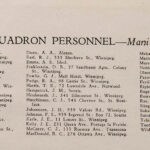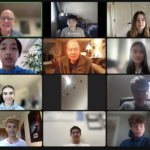Richard James Earl was born July 3, 1924 in Winnipeg. He was the youngest of six brothers and three sisters – in a family that covered a wide range of ages. His father was a tailor who made uniforms for Canadian National Railroad employees, particularly the porters, conductors and dining car staff. He had served during the Boer War and the Great War and was honored for saving a wounded man. During the depression, Richard and his brothers would carry sacks of 10 loaves of day-old bread home for .25. The City of Winnipeg also converted a vacant lot for the residents to manage a vegetable garden. Out of school, Richard was a machinist apprentice for 5 years with the CN RR. When the war came, his older brothers enlisted one by one: Richard stated that his mother never revealed her feelings at the time about her sons going off to fight. Fortunately, all of her sons returned home! Richard said that it was inevitable – they had to volunteer or be conscripted. He said that he always wanted to fly, so he opted for the RCAF. They offered him the choice of being a navigator or radio operator (WAG). Richard attended the British Commonwealth Air Training Program (BCATP), attending boot camp at Brandon, Manitoba and #3 Wireless School in Winnipeg. At Dauphin, Manitoba, he learned how to shoot a machine gun. Ready for the war, he transited the Atlantic aboard the Ile de France to Greenock, Scotland. He was assigned to the #62 RAF Transport Squadron and was sent to India and Burma. He participated in the China-Burma-India (CBI) theatre of war. He was attached to the 14th British Army in the Burmese jungle and in Gujarat, India. The RCAF took Richard out of the RAF, though he continued to fly supplies to the British. Close to the fighting, he said that during a take-off, Japanese bullets penetrated the fuselage. Missions were not counted but hours were, often flying over the Himalayas. He said that he flew 2000 hours and the required 700 air miles to be eligible to return to England. Once there, he did participate in V-E Day celebrations. He said that he had many relatives in England and was in no hurry to return to Canada. He flew back and forth from the continent to European capital cities. He returned home by ship from England to NYC and by train to Montreal to Winnipeg in late 1945, marrying Donna and finding his way in postwar Canada. Richard Earl was interviewed by Crestwood students over zoom in October 2024.
Videos
Click next video below to keep watching











